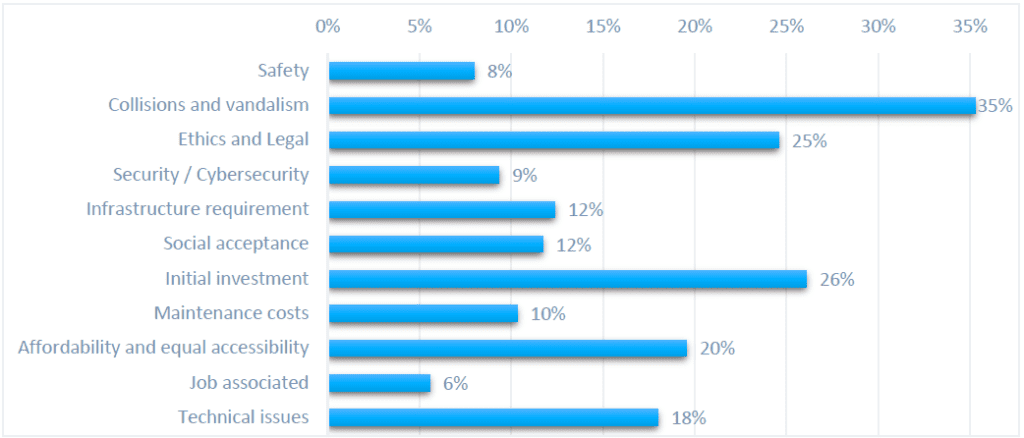The MOVE2CCAM project aims to develop a tool for assessing the impact of autonomous vehicles (AVs) on passenger and freight transport using systems dynamic modelling. To gather the data required for modelling the tool, the project has collected perceptions from different co-creation activities across eight European countries where project partners are located: UK, Spain, France, Germany, Cyprus, the Netherlands, Poland, and Greece. The project will engage a total of 8,768 citizens and 300 organizations, encompassing businesses, authorities, research entities, and NGOs in mobility, ICT, and health sectors.
Co-creation Activities & Their Findings
The first 2 co-creation activities focused on developing use cases (gathered on the Knowledge bank) for both passenger transportation and freight through autonomous vehicles and identify their own local transportation challenges. Activity 1 co-created with organizations and activity 2 with citizens. Both aimed to gather ideas about autonomous vehicles for the travel and mobility needs of organizations and the public, while identifying challenges, potential impacts, and deployment timelines.
Challenges Identified
As shown in Figure 1 , eleven primary challenges surrounding the adoption and implementation of AVs in the different research countries were identified. Taking into account the total number of participants, from both organisations and citizens, Figure 1 shows the percentage of participants that identified this challenge.

Figure 1 Challenges identified during MOVE2CCAM activities related to AVs systems
Each challenge is presented below, accompanied by its relevance across the eight countries:
Safety – Safety was highlighted as a critical concern for the development of autonomous vehicles. Participants emphasized potential risks like theft or harm to vehicle occupants, with elderly, children, disabled individuals, women, and immigrants identified as especially vulnerable. Helpdesk and road assistance were suggested as solutions for breakdowns or user needs. 8% of participants discussed safety concerns, with varying numbers reporting from different countries: 6 from the Netherlands, 4 from Greece, 3 each from Germany, Poland, and the UK, and 1 each from Cyprus, Spain, and France.
Collisions and Vandalism – Concerns circled around potential AV collisions and acts of vandalism. Issues like fare evasion due to the absence of onboard staff and the vehicle’s hygiene were also broached. 35% of participants from activities 1 and 2 mentioned these concerns. Country-wise contributions are as follows: 26 from Greece, 21 from the UK, 15 from Spain, 11 each from Germany and the Netherlands, 10 from Poland, 6 from France, and 4 from Cyprus, Spain and France.
Ethic and Legal – This challenge encompasses concerns about determining liability in the event of accidents with autonomous cars and deciding who should provide insurance. Questions were raised about the minimum age to use such cars and the need for legislative adaptations. Ethical dilemmas include deciding whom to prioritize in a collision. 25% of participants from activities 1 and 2 addressed these ethical and legal issues, with specific participation numbers from the UK (16), France and Greece (12 each), Germany (10), Cyprus, Spain, and Poland (5 each), and the Netherlands (4).
Security/Cybersecurity – Participants voiced concerns over the privacy and security risks associated with autonomous vehicles (AVs), especially regarding data collection for surveillance and the potential for hacking or cyber-attacks leading to vehicle malfunctions. 9% of participants across both activities highlighted these security and cybersecurity concerns. Specifically, this challenge was noted by participants from Greece (11), the Netherlands (6), Spain, Poland, and the UK (3 each), Germany (2), and France (1). No participants from Cyprus mentioned this issue.
Infrastructure Requirement – Participants emphasized challenges for autonomous vehicles (AVs) in navigating complex urban designs prevalent in many European cities. Concerns were raised about AVs operating in areas where they might struggle to perceive their surroundings or where required infrastructure is lacking. Greater risks were associated with mixed traffic conditions than with a complete AV deployment. 12% of participants across activities mentioned challenges related to urban design or road infrastructure interactions. These concerns were voiced by participants from Greece (22), Germany (6), Spain, the Netherlands, and the UK (3 each), and Cyprus and Poland (2 each). No feedback on this was reported from France.
Social Acceptance – Participants discussed the potential rejection of AVs by citizens due to mistrust or lack of interest, as current transport needs might already be met by existing services. This could lead to reduced investment from vehicle manufacturers and a reluctance by municipalities to adopt AVs. 12% of participants across activities mentioned concerns related to the public’s potential rejection of AVs. Feedback came from Greece (11 participants), the UK (5), Cyprus, Spain, and Poland (4 each), France (3), and Germany (2). There were no reports on this challenge from the Netherlands.
Initial Investment – Participants highlighted concerns about the high costs of autonomous vehicles, including the initial investments in infrastructure and sensors. This could also influence the pricing of transport services provided by these vehicles. There’s a need for viable business models to ensure profitability for companies and affordability for the public. 26% of participants across activities identified high initial investment as a concern. Feedback came from Greece (20 participants), Spain (17), the UK (16), Germany (11), France (5), Cyprus (4), Poland (3), and the Netherlands (2).
Maintenance Costs – While some participants saw potential for reduced maintenance costs, others were concerned about the novelty and associated repair costs of the technology. The average relevance of this challenge shows that 10% of all participants involved in activities 1 and 2 mentioned any question related to maintenance costs. The relevance of this challenge indicates that was reported by 16 participants from Greece, 5 from UK, 4 from Spain, 3 from Germany and France, 2 from Poland and 1 participant from Cyprus. Nobody from the Netherlands reported this impact.
Affordability and Equal Accessibility – Participants discussed concerns that the high costs of autonomous vehicles (AVs) might make them only accessible to the wealthy and emphasized the need for these vehicles to accommodate those with limited mobility. There were debates about where AV services should first be introduced. Rural residents felt AVs could address transportation gaps for vulnerable groups like the elderly and attract young people, potentially stabilizing rural populations. Yet, some believed decision-makers might prioritize urban areas for AVs due to higher rural implementation costs and the hesitance of older people to use them. 20% of participants touched on affordability and equal accessibility. Feedback was provided from the Netherlands (13 participants), the UK (11), Poland (9), Germany (8), France and Greece (5 each), and Spain (4). No feedback came from Cyprus.
Jobs Associated with AVs – Participants expressed concerns about job losses resulting from the introduction of autonomous vehicles (AVs). While some noted AVs could create new roles, these would likely be technical or specialized positions. 6% of participants raised concerns about job impacts, with feedback coming from Spain (4 participants), Germany, Poland, and the UK (3 each), and Cyprus and France (1 each). No feedback on this issue was received from Greece or the Netherlands.
Technical Issues – Participants raised concerns about potential technical issues with autonomous vehicles, including technology failures, electronic malfunctions, battery life, GPS inaccuracies, and internet connectivity problems. They also emphasized the importance of punctuality, sufficient vehicle frequency, and the availability of charging stations. 18% of participants mentioned these technical challenges. Feedback was primarily from the UK (16 participants), Greece (11), Germany (9), Spain and Poland (6 each), with limited input from Cyprus and the Netherlands (1 each).
The varied concerns raised by participants from different European countries highlighted the differences in socio-cultural beliefs, economic realities, and infrastructure challenges that exist across the continent. Each country’s unique history, culture, and socio-economic conditions play a pivotal role in shaping citizens’ perceptions and apprehensions towards new technologies like AVs. For instance, a historically pedestrian-centric city might view AVs differently than a city designed around automobiles. Similarly, a country with a robust technology sector might emphasize cybersecurity concerns more than a country where infrastructure development is the primary concern. For these reasons, MOVE2CCAM uniquely addresses the myriad challenges surrounding autonomous vehicles (AVs) in Europe. By actively engaging diverse stakeholders from multiple countries, it captures a broad spectrum of concerns, from infrastructure to socio-economic implications. This inclusive, bottom-up approach ensures that solutions aren’t just technically feasible but are also tailored to the socio-cultural and economic landscapes of each nation. Through its holistic analysis, stakeholder engagement, and emphasis on inclusivity and awareness, MOVE2CCAM offers a roadmap that is both adaptable and forward-thinking, turning challenges into opportunities for the successful integration of AVs.
Identifying these challenges served as a starting point for co-developing numerous use cases and consequently, the corresponding business models that would provide an answer to the local mobility and transport challenges.



